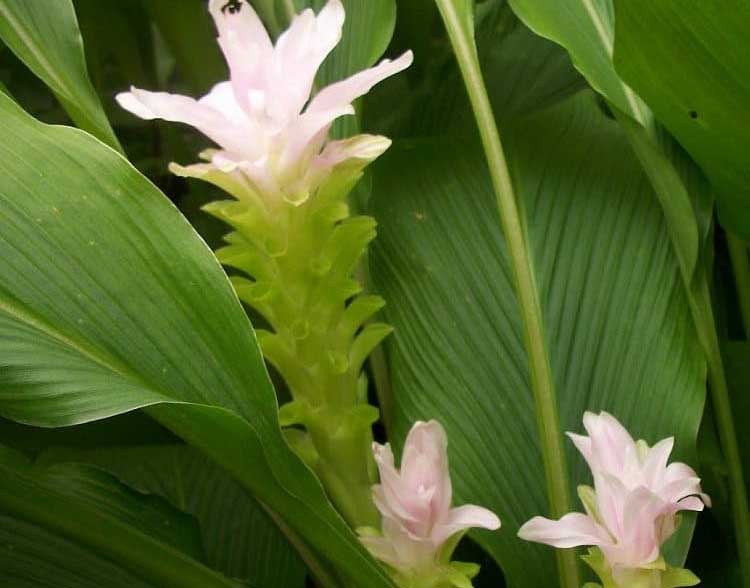Name: Turmeric (Curcuma longa)
Otherwise known as: Indian Saffron
Habitat: An herbaceous perennial closely related to ginger and a member of the family Zingiberaceae. It grows to about one metre in tropical monsoon regions, has large lily-like leaves, similar to canna, which enclose small yellow flowers with pink bracts.
What does it do: The plant is grown for its aromatic rhizome which is cleaned, boiled, sun-dried and polished. Because of its bright yellow colour it is used in butter, cheese, margarine and other food products.
Turmeric is a major ingredient of curry powder and used extensively in Chinese and Ayurvedic medicine. It contains curcumin an orange volatile oil consisting of turmerone, atlantone, zingiberone, sugars, resins, proteins, vitamins and minerals. This reputedly makes it anti-oxidant, anti-carcinogenic, anti-inflammatory, anti-microbial and hepatic. In Asian folk medicine it is an all-rounder, treating flatulence, jaundice, menstrual problems, haemorrhage, toothache, bruises, chest pains and colic.
Turmeric extracts exert an anti-oxidant effect similar to vitamin C and E but is more powerful against hydroxyl radicals than either of these, it is most effective in inhibiting oxidative damage to DNA.
Recent research indicates that turmeric and its compounds act against several common mutagens such as cigarette smoke condensates, benzopyrene, DMBA etc. It also displays an impressive ability to reduce the levels of urinary mutagens. In an experiment conducted in I992 fifteen chronic smokers were given a daily dose of turmeric and after a period of thirty days it was discovered that the mutagen level in their urine was reduced by a half.
Turmeric enhances the body’s natural anti-oxidant system and inhibits nitrosamine formation. A sister plant, C.zeoaria, has been shown to reduce cervical cancers and increased the effectiveness of chemo and radiotherapy.
As an anti-inflammatory turmeric is as effective as cortisone and phenylbutazone and displays none of the toxicity associated with them. An ancient remedy was to create a poultice by mixing turmeric with slaked lime and apply it to sprains and inflamed joints. The plant works in the same way as capsaicin (ibid) by suppressing the activity of substance P, the neurotransmitter of pain receptors. In a double-blind test one group of patients suffering from rheumatoid arthritis were given extract of turmeric, and the other phenylbutazone. The improvement in the duration of morning stiffness, walking time, and joint swelling were the same in both groups, but those given turmeric extract suffered no side effects.
Turmeric is known to reduce cholesterol levels by interfering with the intestinal uptake and thereby increasing the conversion of cholesterol into bile acids. Similarly, it has a beneficial effect on the liver, protecting it against chemical injury.
High concentrations of the plant are used effectively against staphylococcus, streptococcus and bacillus; in addition they are potent against several pathogenic fungi.
The Thais include the shoots and flowers of the plant in several traditional dishes and use an extract as a counter to cobra envenomation,
Turmeric has been used as a fabric dye for millennia and features in many Hindu ceremonies.
Alexander McCowan .Author of The World’s most Dangerous Plants’.







Click here to change your cookie preferences